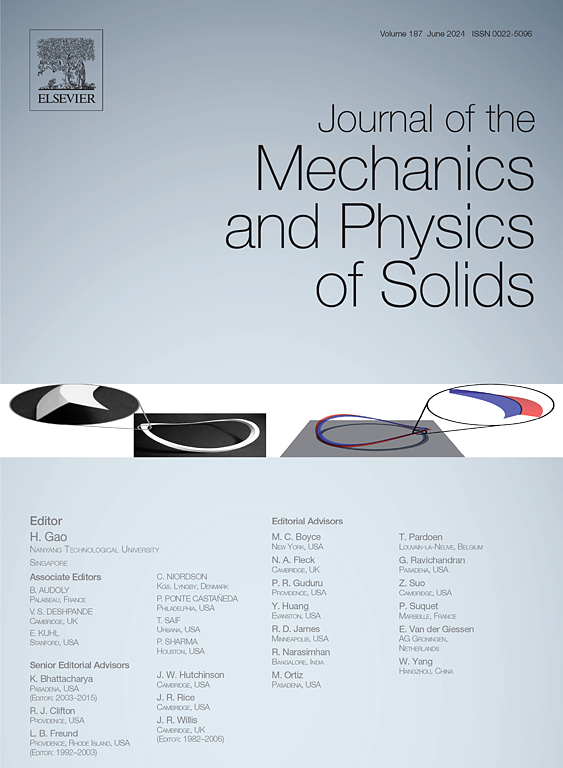Elastic Plateau–Rayleigh instability in soft cylinders: Surface elasticity and periodic beading
IF 6
2区 工程技术
Q2 MATERIALS SCIENCE, MULTIDISCIPLINARY
引用次数: 0
Abstract
The Plateau–Rayleigh instability shows that a cylindrical fluid flow can be destabilized by surface tension. Similarly, capillary forces can make an elastic cylinder unstable when the elastocapillary length is comparable to the cylinder’s radius. While existing models predict a single isolated bulge as the result of an instability, experiments reveal a periodic sequence of bulges spaced out by thinned regions, a phenomenon known as beading instability. Most models assume that surface tension is independent of the deformation of the solid, neglecting variations due to surface stretch.
In this work, we assume that surface tension arises from the deformation of material particles near the free surface, treating it as a pre-stretched elastic surface surrounding the body. Using the theoretical framework proposed by Gurtin and Murdoch, we show that a cylindrical solid can undergo a mechanical instability with a finite critical wavelength if the body is sufficiently soft or axially stretched. Post-buckling numerical simulations reveal a morphology in qualitative agreement with experimental observations. Period-halving secondary bifurcations are also observed. The results of this research have broad implications for soft materials, biomechanics, and microfabrication applications where surface tension plays a crucial role.
软圆柱体的弹性高原-瑞利不稳定性:表面弹性和周期性旋流
高原-瑞利不稳定性表明,表面张力可以使圆柱形流体流动不稳定。同样,当弹性毛细管长度与圆柱体半径相当时,毛细力可以使弹性圆柱体不稳定。虽然现有的模型预测单个孤立的凸起是不稳定的结果,但实验揭示了由薄区域间隔的周期性凸起序列,这种现象被称为串珠不稳定。大多数模型假设表面张力与固体的变形无关,忽略了表面拉伸引起的变化。在这项工作中,我们假设表面张力是由材料颗粒在自由表面附近的变形引起的,将其视为围绕身体的预拉伸弹性表面。利用Gurtin和Murdoch提出的理论框架,我们表明,如果圆柱形固体足够柔软或轴向拉伸,则它可以在有限的临界波长内经历机械不稳定性。屈曲后的数值模拟结果与实验观察结果在定性上一致。周期减半的二次分岔也被观察到。这项研究的结果对软材料、生物力学和表面张力起关键作用的微加工应用具有广泛的意义。
本文章由计算机程序翻译,如有差异,请以英文原文为准。
求助全文
约1分钟内获得全文
求助全文
来源期刊
CiteScore
9.80
自引率
9.40%
发文量
276
审稿时长
52 days
期刊介绍:
The aim of Journal of The Mechanics and Physics of Solids is to publish research of the highest quality and of lasting significance on the mechanics of solids. The scope is broad, from fundamental concepts in mechanics to the analysis of novel phenomena and applications. Solids are interpreted broadly to include both hard and soft materials as well as natural and synthetic structures. The approach can be theoretical, experimental or computational.This research activity sits within engineering science and the allied areas of applied mathematics, materials science, bio-mechanics, applied physics, and geophysics.
The Journal was founded in 1952 by Rodney Hill, who was its Editor-in-Chief until 1968. The topics of interest to the Journal evolve with developments in the subject but its basic ethos remains the same: to publish research of the highest quality relating to the mechanics of solids. Thus, emphasis is placed on the development of fundamental concepts of mechanics and novel applications of these concepts based on theoretical, experimental or computational approaches, drawing upon the various branches of engineering science and the allied areas within applied mathematics, materials science, structural engineering, applied physics, and geophysics.
The main purpose of the Journal is to foster scientific understanding of the processes of deformation and mechanical failure of all solid materials, both technological and natural, and the connections between these processes and their underlying physical mechanisms. In this sense, the content of the Journal should reflect the current state of the discipline in analysis, experimental observation, and numerical simulation. In the interest of achieving this goal, authors are encouraged to consider the significance of their contributions for the field of mechanics and the implications of their results, in addition to describing the details of their work.

 求助内容:
求助内容: 应助结果提醒方式:
应助结果提醒方式:


